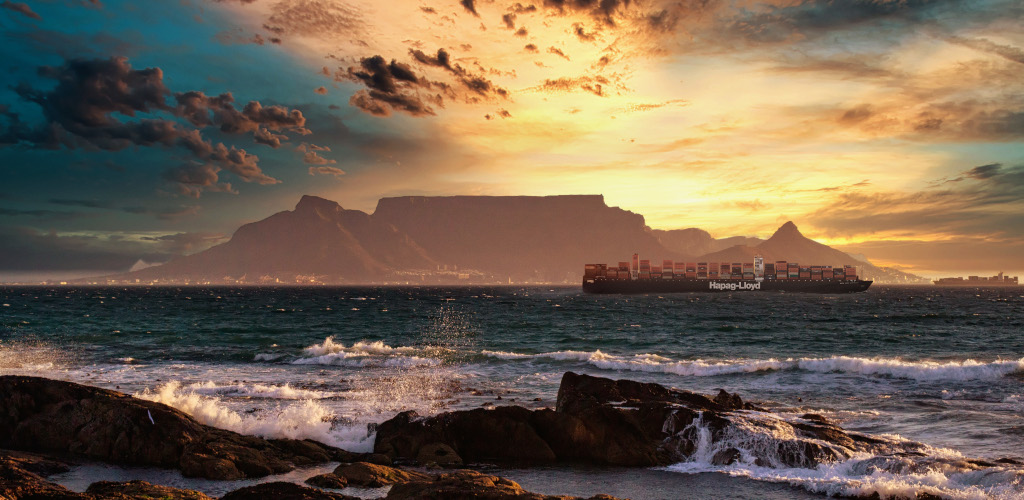Apr 24 | 2024
Uncertainty Looms but Some South Africans See a Silver Lining
 By Liesl Venter
By Liesl VenterShipping disruption caused by escalating Houthi attacks in the Red Sea, ongoing since December, have emerged as one of the biggest maritime challenges in decades. Amid the turmoil, there’s a glimmer of hope in Africa – could the influx of vessels around the South African coast present opportunities?
From Issue 3, 2024 of Breakbulk Magazine.
(5-minute read)
Shipping disruption caused by escalating Houthi attacks in the Red Sea, ongoing since December, have emerged as one of the biggest maritime challenges in decades. The strategic waterway has become a focal point of uncertainty and with each passing day, the situation intensifies, casting a shadow of doubt over the stability of international shipping routes.
Instead of navigating through perilous waters, most vessel lines are opting to divert around Africa, leading to soaring costs and emissions. Predicting the trajectory of the situation is difficult, leaving the shipping industry apprehensive. As disruptions continue, stakeholders have been warned to brace for ongoing impacts on pricing, space, utilization, reliability and transit times.
 Amid the turmoil, there’s a glimmer of hope in Africa. Commander Tsietsi Mokhele, a maritime and ocean economy expert and president and executive director of the Africa Oceans Council (AOC), notes that the influx of vessels around the South African coast presents opportunities as increased maritime traffic could stimulate economic growth and trade expansion in the region.
Amid the turmoil, there’s a glimmer of hope in Africa. Commander Tsietsi Mokhele, a maritime and ocean economy expert and president and executive director of the Africa Oceans Council (AOC), notes that the influx of vessels around the South African coast presents opportunities as increased maritime traffic could stimulate economic growth and trade expansion in the region.“The Suez and Panama Canals pose significant risks to shipping, even during peaceful times,” he says. “There has been a longstanding need for a configuration that mitigates these risks, and circumnavigating Africa presents the solution.”
Mokhele immediately acknowledges the prevailing mantra that the Cape Sea Route is longer than the Suez and, therefore, more costly with higher emissions. “I don’t necessarily agree that it is more costly. There has been a notable oversight, considering the real economics of international shipping logistics and maritime trade.
“Empirical evidence suggests that whilst the route is longer, the Cape can compete successfully against the Suez route on as many as 11 trade lanes crisscrossing the Cape.”
Of course, he says that for the Cape Sea Route to become a viable alternative to the risky Red Sea and, in part, the Panama Canal, it has to be fiercely competitive, agreeing that it is not the case at present.
“It all depends on the availability and functioning of a globally competitive full-service maritime hub near the Cape. South Africa is the only country with the location, infrastructural capacity and capabilities to develop and offer maritime hub services at scale necessary to impact the immediate crisis and long-term shipping requirements.”
Makings of a Transshipment Hub
Mokhele says South Africa already has the makings of an international transshipment hub developing around the twin ports complex of Algoa Bay, with Port Elizabeth serving as a regional gateway port while the new Port of Ngqurha was purpose-built as a dedicated international transshipment port.
“Algoa Bay holds a distinctive advantage as it sits directly along the primary shipping route. In contrast to other areas that serve traffic from a single direction, like east, north, or west, it accommodates incoming and outgoing maritime traffic effortlessly. This means minimal or no need for ships to divert from their course to access bunkering and other off-port services.”
Peter Besnard, CEO of the South African Association of Ships Operators and Agents (SAASOA), acknowledges Mokhele’s perspective that the crisis’s potential for opportunity, particularly in increased bunkering and port services demand, holds merit. However, he emphasizes that shipping costs persist at elevated levels across sectors, making this route option costly and probably unsustainable in the long run.
“Vessels are required to take on additional bunkers, stores and provisions for the additional number of days required to round the Cape, estimated to be 10 to 12 days to Europe,” says Besnard.
“With vessels required by IMO regulations to use low sulfur fuel for $700 plus per metric ton and considering that South Africa is the most expensive globally, the additional cost for a vessel rounding the Cape could be anything from $50,000 to $100,000 incurred over and above normal costs which the lines want to recover and add to the overall cost of the cargo ultimately finding its destination.”
The Transnet National Port Authority (TNPA), responsible for the regulatory functions at all of South Africa’s eight commercial ports, says it has seen a definite increase in bunkering calls. “There were 217 bunker vessel calls between January and February this year, of which 47 were due to the Red Sea crisis,” says Captain Rufus Lekala, TNPA chief harbor master. “The calls have mainly been at Durban and Cape Town ports. The Port of Cape Town had more calls largely due to the higher number of tankers.”
The Challenges of Rerouting
Mokhele and other South African maritime experts’ aspirations for a long-term African shipping hub appear to be dashed from the start. The TNPA is not optimistic that it will see long-term benefits over the Red Sea crisis.
“Our view is that the affected countries are working on resolving the situation as this cannot be sustainable for shipping lines and the global logistics chain. It is difficult to comment on the duration of this crisis. Therefore, opportunities may be for a minimal period and not worth making substantial capital investments to accommodate the diverted vessels. Once the situation normalizes, the vessels will return to the shorter, more cost-effective route,” says Captain Lekala.
Yorck Niclas Prehm, head of research at Toepfer Transport, says there are no indications that lines will not return to Suez once the crisis ends. It is, however, anyone’s guess how long the situation will continue. He warns that the situation will continue to significantly impact rates in the MPV sector for all – whether opting to reroute or use Suez.
 “In February 2023, 63 percent of ships sailed via Suez compared to only 37 percent opting to go around the Cape. Only 27 percent used the Suez Canal in February this year, and 73 percent took the longer route. There are costs for those using the route and those who are choosing not to,” he tells Breakbulk.
“In February 2023, 63 percent of ships sailed via Suez compared to only 37 percent opting to go around the Cape. Only 27 percent used the Suez Canal in February this year, and 73 percent took the longer route. There are costs for those using the route and those who are choosing not to,” he tells Breakbulk.“Urgent cargo that cannot be delayed is still moving through Suez, but the cost is high as the premiums and security measures come at a price. The costs involved are calculated day to day depending on the risk. Rerouting via the Cape also carries a higher cost as the sailing time is longer, and therefore, the utilization of vessels is higher.”
The situation will continue for the foreseeable future. “In the MPV sector, there is the benefit of some room for maneuver as more forward planning can happen. We have also seen the sector less impacted by the crisis than container lines, as there is a different approach to cargo loading,” says Prehm.
Additional tonnage miles created by ships sailing via the Cape will continue increasing fleet utilization, the Toepfer executive adds. On the operational side, this will require adjustments to mid-term and long-term scheduling that will ultimately help stabilize the charter market.
Niels Rasmussen, chief shipping analyst at BIMCO, says container vessels and gas tankers, in particular, have been most affected. “Transits are nearly 70 percent lower than last year. The reduction in Suez Canal transits has only been 16 percent and 41 percent for bulkers and multipurpose ships. The impact on these sectors has consequently been less pronounced, but for all sectors, the rerouting results in increased demand for ships and, therefore, higher freight rates than would otherwise have been the case.”
Adapting to Higher Costs
Increased costs have been unavoidable, says dship COO Christoph Dehlau, indicating that the shipping company had to adapt swiftly, redirecting its vessels from the Red Sea. “We have worked hard to ensure minimal disruption to operations and scheduling.
“While longer voyages may lead to challenges such as tonnage shortages and potential delays on forward fixed business, our team has been adept at rerouting vessels efficiently and renegotiating shipment times to maintain smooth operations.”
However, fuel consumption and bunker expenses have naturally risen, with vessels spending more time at sea.
“Navigating vessels around the Cape also does involve some considerations. Slight variations in weather patterns and differences in the availability of bunker hubs compared to previous routes may necessitate minor adjustments. Additionally, occasional backlogs at hubs such as Gibraltar are possible, which could result in slight schedule disruptions and increased transit times. However, these challenges are generally manageable and do not present significant operational hurdles,” Dehlau says.
Shifts in Demand
Interestingly, the entire situation has led to a notable shift from customers, notes Dehlau. “Many clients are proactively seeking reroutes, with a notable number issuing internal policies to avoid the Red Sea entirely. This shift in mindset underscores the paramount importance placed on ensuring the safety and security of both cargo and crew.
“It’s crucial to note that while enhancing security measures can be somewhat effective regarding piracy, terrorist threats present a different level of complexity and risk. Unfortunately, there are no instruments available to deter these threats effectively. Therefore, redirecting vessels remains the most prudent course of action to prioritize the safety and security of our crew and cargo.”
According to Rasmussen, considering that it is impossible to know how long the attacks on merchant ships will continue, the main risk for the industry will be whether shipping companies can recoup the additional costs for sailing via the Cape from their customers.
“The impacts are, of course, dependent on the origin and destination of the ships. For example, a ship sailing from Singapore to Rotterdam will sail 3,500 nautical miles (equal to 42 percent) longer via the Cape than via the Suez Canal. The extra cost for a specific voyage will be the additional fuel needed to sail the longer distance, whereas more ships will be needed for the whole market to transport the same amount of cargo.”
Already, container carriers have injected more ships into the affected trades to maintain the average frequency of sailings. A Hapag- Lloyd spokesperson says the liner is looking at additional costs in a U.S. dollar two-digit million range every month. “It is just too early to conclude shifts in customer demand or trade patterns. At this stage, our focus remains on ensuring the continuity of our customers’ supply chains. We have increased capacity, adapted our services and increased the frequency of departures to meet evolving needs.”
For Mokhele and others hoping to see more benefit for South Africa, the Red Sea crisis underscores the vital importance of resilience in global supply chains, emphasizing the necessity for project and breakbulk shippers to consider a broader range of routes and delivery options for their cargo.
“The Suez Canal is one supply chain. The current crisis offers the ideal opportunity to explore alternative routes not only as an immediate solution but as a viable option in the future.”




